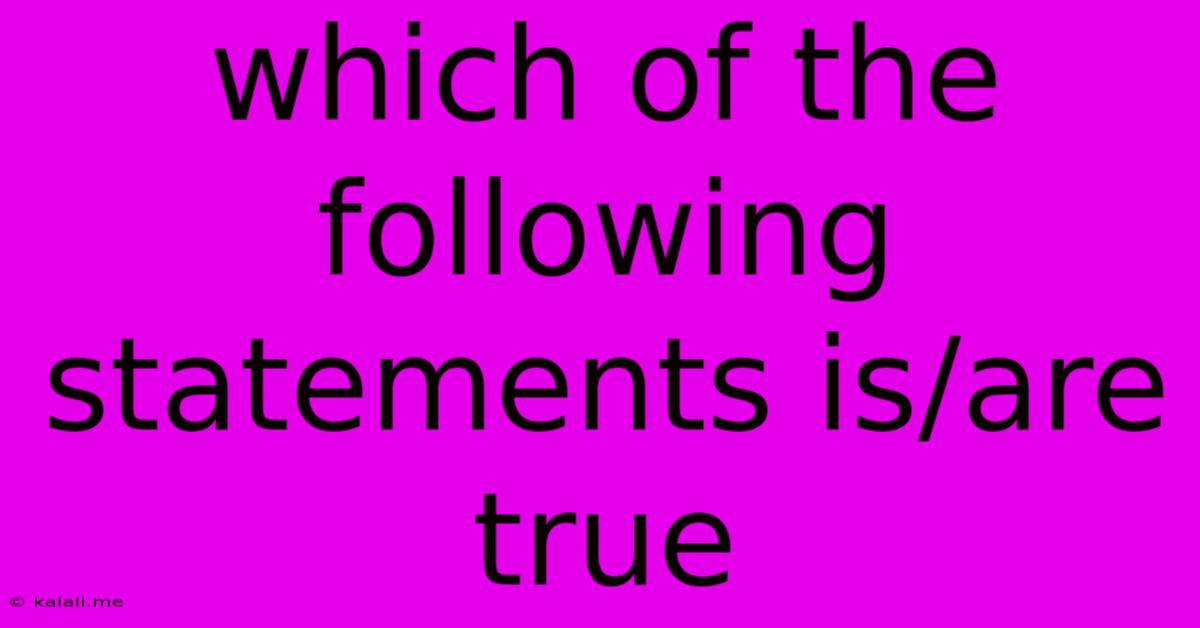Which Of The Following Statements Is/are True
Kalali
Jun 11, 2025 · 3 min read

Table of Contents
Decoding Truth: How to Determine the Validity of Statements
Determining the truthfulness of statements is a crucial skill in many aspects of life, from everyday conversations to complex academic debates. This article will explore how to effectively analyze statements and determine their validity, providing you with a framework to confidently assess information. This is particularly useful in critical thinking, problem-solving, and even navigating the ever-growing spread of misinformation online.
Understanding the Challenge:
The process of discerning truth is often more nuanced than simply identifying "true" or "false." Statements can be:
- Completely True: Accurately reflects reality.
- Completely False: Does not reflect reality; contains inaccuracies or falsehoods.
- Partially True: Contains elements of truth but also inaccuracies or misleading information.
- Ambiguous: Unclear or open to multiple interpretations, making it difficult to determine truthfulness.
- Opinion-based: Subjective and reflects personal beliefs rather than objective facts.
Strategies for Evaluating Statements:
To effectively evaluate a statement, consider the following:
1. Identify the Claim and Its Components:
Break down the statement into its core components. What is the main claim being made? What evidence or assumptions are being presented? Understanding the individual parts allows for a more focused analysis. For example, in the statement "Cats are better pets than dogs because they are quieter," the claim is that cats are superior pets, the reason given is their quiet nature, and the underlying assumption is that quietness is the most desirable pet trait.
2. Assess the Evidence:**
What evidence is provided to support the claim? Is the evidence reliable and credible? Consider the source of the information: is it from a reputable source, or is it biased or unreliable? Look for concrete data, studies, or verifiable facts. Anecdotal evidence, while sometimes helpful, is generally insufficient to support a broad claim.
3. Check for Biases and Logical Fallacies:**
Are there any biases present in the statement or the way it is presented? Common logical fallacies, such as straw man arguments, ad hominem attacks, and appeals to emotion, can weaken or invalidate a statement. Being aware of these fallacies helps to identify weaknesses in the argument.
4. Consider Multiple Perspectives:**
Avoid confirmation bias by seeking out diverse perspectives on the issue. Examine the statement from different angles and consider counterarguments. A comprehensive understanding requires considering all sides of the issue.
5. Evaluate the Context:**
The context in which a statement is made is crucial to its interpretation. A statement that is true in one context might be false in another. Therefore, considering the surrounding circumstances is essential to accurate assessment.
6. Verify Information from Multiple Reliable Sources:**
Don't rely on a single source. Cross-reference information with multiple reputable sources to ensure accuracy and avoid misinformation. This is especially important in today's digital age, where false information can spread rapidly.
Applying the Strategies: An Example
Let's say we have the statement: "Exercise is beneficial for overall health."
- Claim: Exercise improves overall health.
- Evidence: Numerous scientific studies demonstrate the positive effects of exercise on cardiovascular health, weight management, and mental well-being.
- Bias/Fallacies: None apparent.
- Perspectives: While some individuals may have limitations preventing strenuous exercise, the overall consensus supports its benefits.
- Context: The type and intensity of exercise might need to be adjusted based on individual health conditions.
- Verification: This is supported by countless studies published in peer-reviewed journals.
Based on this analysis, we can conclude that the statement "Exercise is beneficial for overall health" is largely true, though with the important caveat of considering individual circumstances.
By employing these strategies, you can confidently analyze statements and determine their validity, becoming a more discerning consumer of information and a more effective communicator. Remember that critical thinking and careful evaluation are crucial in navigating the complexities of information in today's world.
Latest Posts
Latest Posts
-
How Many Chicken Thighs In A Pound
Jul 01, 2025
-
How Old Is Someone Born In 1992
Jul 01, 2025
-
How Many Grams Is In A Pint
Jul 01, 2025
-
Lyrics To The Song Stand By Donnie Mcclurkin
Jul 01, 2025
-
How Much Is 3 Quarts Of Water
Jul 01, 2025
Related Post
Thank you for visiting our website which covers about Which Of The Following Statements Is/are True . We hope the information provided has been useful to you. Feel free to contact us if you have any questions or need further assistance. See you next time and don't miss to bookmark.